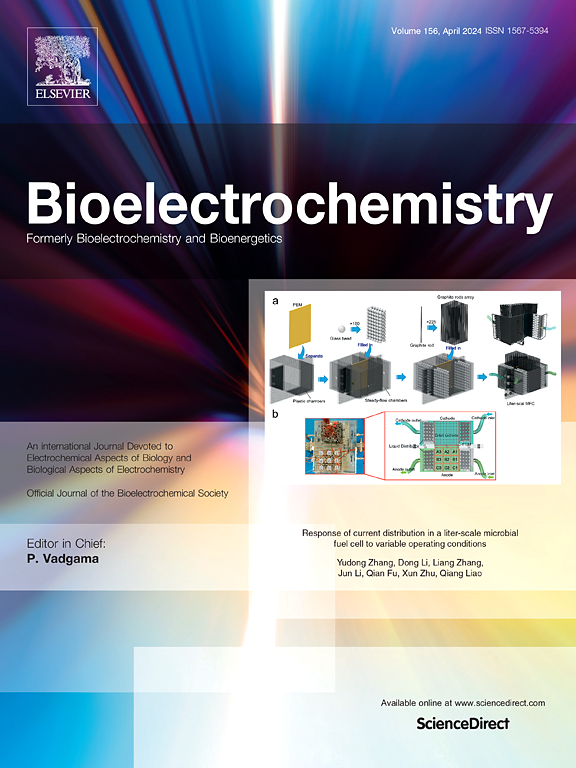Synergistic effects of amoxicillin and silver metal in combating bacterial infections: A novel approach to overcoming antibiotic resistance
IF 4.5
2区 化学
Q1 BIOCHEMISTRY & MOLECULAR BIOLOGY
引用次数: 0
Abstract
This study focuses on the synthesis of the compounds based amoxicillin and silver, while highlighting their increased efficacy against bacterial infections and their potential to fight antibiotic resistance. The synergy has been achieved in two forms: an amoxicillin‑silver complex (AMX![]() Ag) and amoxicillin-stabilized silver nanoparticles (AMX-AgNPs). The interaction between amoxicillin and silver ions (Ag+) was investigated using electrochemical and spectroscopic methods. The synthesized AMX-Ag complex and AMX-AgNPs were thoroughly characterized using a range of physicochemical techniques to determine their structural and functional properties. The UV–visible result confirmed the formation of the coordination compound, which is consistent with the electrochemical data that showed changes in the oxidation peak of AMX in the presence of Ag(I) ions. The XRD analysis of the synthesized AMX-AgNPs revealed a face-centered cubic (fcc) lattice structure.
Ag) and amoxicillin-stabilized silver nanoparticles (AMX-AgNPs). The interaction between amoxicillin and silver ions (Ag+) was investigated using electrochemical and spectroscopic methods. The synthesized AMX-Ag complex and AMX-AgNPs were thoroughly characterized using a range of physicochemical techniques to determine their structural and functional properties. The UV–visible result confirmed the formation of the coordination compound, which is consistent with the electrochemical data that showed changes in the oxidation peak of AMX in the presence of Ag(I) ions. The XRD analysis of the synthesized AMX-AgNPs revealed a face-centered cubic (fcc) lattice structure.
Their antibacterial efficacy was then evaluated against Escherichia coli (E. coli) through the agar diffusion method. The results revealed that both the AMX-Ag complex and AMX-AgNPs exhibited a marked enhancement in bactericidal activity compared to amoxicillin alone. This suggests that these formulations hold significant promise as alternative therapeutic strategies for combating E. coli infections, particularly those resistant to conventional antibiotic treatments.
阿莫西林和金属银在对抗细菌感染中的协同作用:一种克服抗生素耐药性的新方法
这项研究的重点是阿莫西林和银基化合物的合成,同时强调它们对细菌感染的增强功效和它们对抗抗生素耐药性的潜力。协同作用以两种形式实现:阿莫西林-银复合物(AMXAg)和阿莫西林稳定的银纳米颗粒(AMX-AgNPs)。用电化学和光谱方法研究了阿莫西林与银离子(Ag+)的相互作用。利用一系列物理化学技术对合成的AMX-Ag配合物和AMX-AgNPs进行了全面表征,以确定其结构和功能特性。紫外可见结果证实了配位化合物的形成,这与电化学数据一致,表明Ag(I)离子存在下AMX的氧化峰发生了变化。合成的AMX-AgNPs的XRD分析显示为面心立方(fcc)晶格结构。通过琼脂扩散法评价其对大肠杆菌的抑菌效果。结果表明,与单独使用阿莫西林相比,AMX-Ag复合物和AMX-AgNPs的杀菌活性均有显著增强。这表明这些制剂作为对抗大肠杆菌感染的替代治疗策略具有重要的前景,特别是那些对传统抗生素治疗具有耐药性的大肠杆菌感染。
本文章由计算机程序翻译,如有差异,请以英文原文为准。
求助全文
约1分钟内获得全文
求助全文
来源期刊

Bioelectrochemistry
生物-电化学
CiteScore
9.10
自引率
6.00%
发文量
238
审稿时长
38 days
期刊介绍:
An International Journal Devoted to Electrochemical Aspects of Biology and Biological Aspects of Electrochemistry
Bioelectrochemistry is an international journal devoted to electrochemical principles in biology and biological aspects of electrochemistry. It publishes experimental and theoretical papers dealing with the electrochemical aspects of:
• Electrified interfaces (electric double layers, adsorption, electron transfer, protein electrochemistry, basic principles of biosensors, biosensor interfaces and bio-nanosensor design and construction.
• Electric and magnetic field effects (field-dependent processes, field interactions with molecules, intramolecular field effects, sensory systems for electric and magnetic fields, molecular and cellular mechanisms)
• Bioenergetics and signal transduction (energy conversion, photosynthetic and visual membranes)
• Biomembranes and model membranes (thermodynamics and mechanics, membrane transport, electroporation, fusion and insertion)
• Electrochemical applications in medicine and biotechnology (drug delivery and gene transfer to cells and tissues, iontophoresis, skin electroporation, injury and repair).
• Organization and use of arrays in-vitro and in-vivo, including as part of feedback control.
• Electrochemical interrogation of biofilms as generated by microorganisms and tissue reaction associated with medical implants.
 求助内容:
求助内容: 应助结果提醒方式:
应助结果提醒方式:


